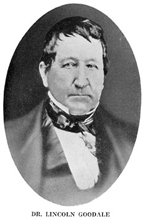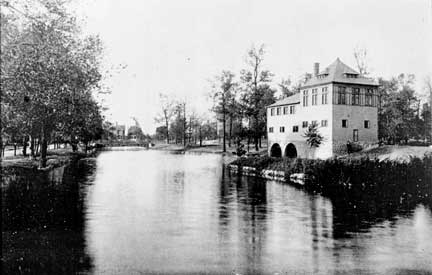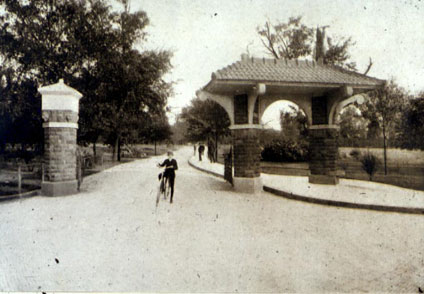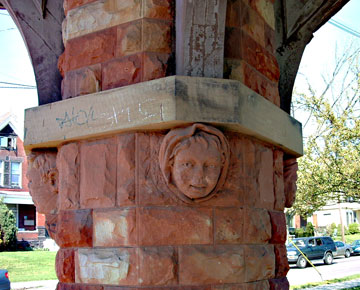
Columbus, Ohio USA
Return to Homepage www.shortnorth.com
The Short North That Was
Dr. Lincoln Goodale and His Living Legacy
Part Six
May 2007 Issue
by Beverly Mullet Randall
email bmullet@netwalk.com
Goodale Park - The 1880s through the early 1900s
RETURN TO PART ONE
PROCEED TO PART SEVEN
RETURN TO FEATURES INDEX
Dr. Lincoln Goodale, Courtesy of the Columbus Metropolitan Library, Division of Biography, History & Travel The late 1800s and early 1900s seem to have been tumultuous years for Goodale Park as the park seems to have frequently been used as a political tool in city council partisan politics. While the 1870s were a time of improvements, witnessing the construction of a commissioned gate for the south entrance and a lake in the northeast quadrant, the 1880s might be described as a time of retrenchment and catching up on unpaid bills.
When the city council met in March 1881, one of the members presented a bill from the Gas Company for eight years of the park’s unpaid gas bills. Although gas services were billed every three months from June 30, 1870, to March 31, 1879, it was reported that during this eight years the city council had not paid one cent of the gas bill for Goodale Park’s gas service. The dates on the unpaid bills were significant – March 31, 1879, was the exact date that the new council took control of the city.
The following years, the early and mid-1880s, were a fairly quiet time for the park, characterized by events such as a Strawberry Festival hosted with an open invitation to all by the “ladies of the High Street Congregational Church” on a Tuesday afternoon in June, 1881. One notable improvement was the commission of the sculpture of Lincoln Goodale that still greets visitors at the south entrance. In 1888, J. Quincy A. Ward, a noted sculptor, created the bust of Lincoln Goodale for $5000. Half of this cost was borne by the city and the other half by Goodale’s estate. The sculpture is said to bear a striking resemblance to Goodale in his later years. Then, a year later in 1889, a new council committee took control of the park, ushering in an era of elaborate improvements – or extravagances, as they were viewed by some.
The new lake on the west side of the park and the boathouse, 1896.
Courtesy of the Columbus Metropolitan Library, Division of Biography, History & Travel.The New Council Committee of 1889
At their first meeting in April 1889, the new Goodale Park committee decided that a number of radical improvements were needed to improve the park which they declared to be in disgraceful condition. At this meeting, it was decided that they would replace the rickety existing fence with a new fence; finish the east gate and install turnstiles at the side gates; tear down or sell the old animal sheds that had housed the menagerie; tear down and move the stable from the north side of the park to a new location where it would be reinstalled in presentable condition; fill in and sod the gravel bank on the west side which was described as an eyesore; and probably lay a “foot-walk” from the northwest to the southeast ends of the park where “careless pedestrians” had worn a path through the park.
They ordered a number of electric lights to illuminate the park and help detect people using the park for immoral purposes. Water pipes and hydrants were urgently needed since there were no facilities for watering plants and trees at the interior of the park.
The meeting ended with a somewhat political-sounding statement that improving the park on a more elaborate basis was a problem of considerable magnitude and that they planned to make the park all it could be and what the people desired it to be.The Big Lake and Superintendent Topping
In December 1890, the Goodale Park committee accepted the lowest bid from the second batch of bids requested. This bid was 12 cents per cubic yard to construct the proposed lake. Described as a mammoth affair in comparison with the present lake, the new lake would run from the northwest corner along the entire west side of the park and curve around the southwest corner. A rustic footbridge was planned for the narrowest part of the lake. The depth was to be about two feet throughout for boating in the summer and skating in the winter, making it safer than the existing lake that was quite deep in some places.
In August 1891, a reporter visited the park’s new superintendent, Mr. Topping, asking when the lake project would be completed. Mr. Topping said the water could be turned on within three days but it wouldn’t be because the island in the lake needed to be “rip-rapped” with cobblestones so that the dirt wouldn’t float away. There was also talk of building a fountain on the island that would have required laying an additional water pipe.
The pagoda gate at the north entrance of the park donated by William H. Fish in 1899.
Courtesy of the Columbus Metropolitan LibraryStrange Goings-on in the Park: Is Superintendent Topping to Blame?
In July, 1892, the Journal criticized the governance of Goodale Park, claiming that the vandalism and “disgusting conduct prevalent there” was caused in part by a desire to “get rid of” Superintendent Topping. The Journal accused Mr. Topping of failing to secure police protection for the park because of personal differences with city service providers and blamed him for depriving the people of the use of their park as a result.
Another newspaper, commenting on this report, accused the Journal of willfully misrepresenting the facts. This newspaper reported Committee Chairman Croughton and the other committee members had unsuccessfully tried to secure police protection from the Police Superintendent Murphy and had even considered hiring their own security man for the park but decided that was impractical.
Chairman Croughton said the swings in the park had been broken by overgrown boys and hoodlums who were angry that Mr. Topping had told them the swings were for children. Since they had come back to the park at night to do the vandalism, Mr. Topping was not responsible because he could not be expected to watch the park all day and all night.
At this meeting, a “striking scene” in the park was related in which a gentleman who was bicycling in the park with his family witnessed a large crowd of women and girls, gathered around the fountain and, because his curiosity was “excited,” went to investigate. When he arrived he found a “dozen women, not children, without shoes or stockings, and their skirts above their knees, wading in the water and having a great time.” While the gentleman thought this activity was innocent enough, he didn’t think a public park was the place for it and called Mr. Topping who drove them away. The report added that this
incident was only one of many that occurred daily in the park and was the most harmless of them all.The Water Bill Fiasco
At the October 1892 city council meeting, Council President Hinman asked the city Water Works Superintendent, Mr. Alpine, how much water the new lake was using. Mr. McAlpine said with 2 one-inch pipes running at full capacity all the time, the lake was using about 40,000 gallons an hour, or 960,000 gallons a day, which at 6 cents per 1,000 gallons amounted to $57.60 a day for a total of $21,024 a year. President Hinman said that was an outrage for the people of Columbus, especially those who lived in the neighborhood whose cellars were filled with water leaking from the new lake.
President Hinman instructed Superintendent McAlpine to provide an itemized report of water usage by all the city parks after which they would take immediate action. It was anticipated that the water would be turned off immediately so that the new lake would drain, at which time the bed would be cemented or made watertight by some other means.
The Columbus Daily Press-Post reported on the same meeting, calling the Goodale Park Lake a “costly gem indeed” with a subheading: “The Unsightly Mud Hole, for Such is All it Is, Costs the Taxpayers $20,000 a Year.” This newspaper quoted Mr. McAlpine as saying the Water Works had not been paid one “red cent” for water used by lakes in the city’s parks and reported that it was well known that the bottom of the lake was only gravel and sand which would allow the water to escape rapidly. They added that the lake had cost several thousand dollars to build and that the contractor had removed several hundred loads of sand for which the city was never paid. In addition, the lake bed was never tamped and therefore no effort had been made to save water. When the water was turned off, as it assuredly would be, the result would be an enormous mud hole that would be a public health hazard to residents of the north side.
Mr. Croughton, chairman of the Goodale Park committee, thought the water usage figures presented sounded way too high and asked Mr. McAlpine to do a test on the usage. A meter was placed on the south pipe and the water turned on. The meter showed that in one hour 238 cubic feet had passed through so that the rate was 1,785 gallons in one hour at a cost of $10.71. The estimate provided to council had been 40,000 gallons per hour.
Thinking there was something wrong with the meter, Mr. McAlpine attached a second meter to the pipe which indicated 285 feet or 2,137.5 gallons per hour at a cost of 12.825 cents. This was the equivalent of 51,300 gallons per day. Total estimated daily water use for both pipes was set at 102,600 gallons or 857,400 gallons less than the original estimate of nearly one million per day. The actual cost was about $2,409 per year compared to the estimated cost of $21,024 per year.
In light of this new information, Chairman Croughton of the Goodale Park committee sent a communication to the Board of Public Works on November 3, 1892. In it he notified them that the estimate of one million gallons of water a day being turned into the new lake, and the claim that the flooded cellars of people living on Dennison Avenue had been reported in several local newspapers and that he was really annoyed that people believed these falsehoods. He claimed that this misinformation had stopped at least three property sales in the Neil Place vicinity, causing loss to him and damage to property. Therefore, he demanded that an investigation be made and that the results be publicized as thoroughly and extensively as the untruths had been or he would take legal action to recover these property damages.
This communication was forwarded to Superintendent McAlpine who said the estimates he had provided were based on the erroneous notion that the pipes were much larger than their actual circumference. At the same meeting, the Sun Vapor Light Company complained that a large number of the electric lights installed in the park to deter crime had been broken on Halloween. Their request for police protection was referred to the Police Commissioners.
Faces are carved into the pagoda depicting the seven ages of man from Shakespeare's play "As You Like It" Act 2, Scene 7 soliloquy that begins with "All the world's a stage."
Photo/ Beverly Mullet RandallLife Goes On
The water usage controversy eventually blew over and the park continued with both lakes fully operational. In 1899, William H. Fish donated the pagoda gate at the north entrance of the park facing Dennison Avenue. William H. Fish and his father owned and operated the Fish Stone Company and the Fish Press Brick Company. They were the first U.S. manufacturers of bricks made from slate or shale. Faces are carved into the pagoda depicting the seven ages of man from Shakespeare’s play, “As You Like It,” Act 2, Scene 7 soliloquy that begins with “All the world’s a stage.” The Fish residence, built in 1897, is located across the street diagonally from the gate and was built using the same material that would later be used for the park gate. The Sells Circus House stands on the other corner, directly across the street from the gate. It was built in 1904. A number of mansions still surround Goodale Park and the Dennison, Buttles and Neil Avenue area vicinity was the neighborhood for the very wealthy in Columbus until the general shift to E. Broad Street in the late 1880s.
Moving into the early 1900s, a diverse and colorful mix of residents and cultures grew up around the park. Billy Sunday, a famous vangelical minister, operated the Billy Sunday Tabernacle on N. Park Street from 1903 to 1935. Flytown grew up around the south end of the park and there is a plaque in the southwest corner commemorating it. Flytown was a racially diverse melting pot of Italian, Jewish, German, Irish, and Afro-American communities. One theory regarding the origins of the name “Flytown” was that housing was quickly needed for all the workers coming into the area to work in the local industries and, as a result, housing quickly “flew up.” In any event, Flytown became central Ohio’s port-of-entry for immigrants from 17 nationalities, including German, Irish, Jewish, Afro-American, Italian, Swedish, Greek, Hungarian, and other immigrants. This melting pot of nationalities was unique in that they all lived side-by-side in one racially diverse community rather than in separate communities as was usually the case in other cities. Flytown was also commercially diverse with groceries, restaurants, retailers, and craftsmen all operating within the same area. And at the heart of this cacophony of cultures, activity, and growth was Lincoln Goodale’s gift to the people of columbus, Goodale Park.Special thanks to local historian Terry Sherburn and the Columbus Metropolitan Library.
©2007 Short North Gazette, Columbus, Ohio. All rights reserved.



